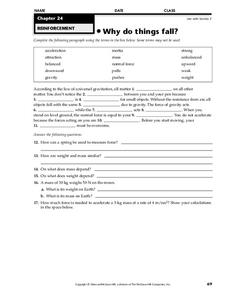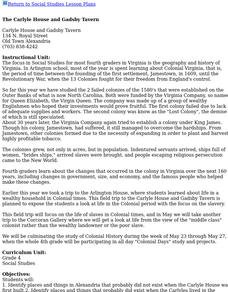Curated OER
Things We Can Learn From a Cow and a Worm
In this conservation instructional activity, students answer 5 questions about how cows and worms recycle and conserve natural resources. Students then fill in a Venn diagram outlining ways they can recycle and conserve.
Curated OER
The Is No Such Thing as a Perfect Pumpkin
Students explore using descriptive words to describe physical appearance. In this appearance lesson, students look at pumpkins and discuss how there is not a perfect pumpkin. Students also hypothesize about what the perfect pumpkin's...
Curated OER
Why Do Things Fall?
In this universal gravitation worksheet, students fill in the blanks to complete sentences with 11 given terms about gravity, inertia, acceleration, mass and force. Students also answer 7 questions about mass, weight and force.
Curated OER
Why Are Hot Things Red?
In this radiation and temperature activity, students use 2 methods to derive the Wein Displacement law that shows the relationship between the temperature of a body to the frequency where the Planck curve's value is at its maximum....
Curated OER
People, Places, and Things
Students review art history in the Memphis Brooks Museum of Art. In this art history lesson, students discuss art vocabulary emphasizing landscape, portrait, and still life. They visit the museum and create their own pictures.
Curated OER
Checkmate: The Play's The Thing
Students investigate the Middle Ages and it's relation to the theater. In this acting lesson, students read Arthurian stories form the Middle Ages and practice using vocabulary words from the Medieval Times. Students write a play set...
Curated OER
The Financial Crisis: What Happened? Where do Things Stand Now?
Students listen to and watch a presentation by Julie Stackhouse on the 2010 financial crisis in the United States. In this economics lesson, students engage in a presentation which is designed to be listened to by High School classes.
Curated OER
Fossils 2: Uncovering the Facts
Students determine what types of information can be determined by looking at fossils. In this fossil lesson, students examine facts about and images of the Tyrannosaurus Rex at an assigned web site. They apply their knowledge to develop...
Chicago Botanic Garden
Introducing Ecosystem Services
Ecosystems provide many things humans not only use but also need in order to survive. The last instructional activity in the series of seven introduces scholars to the idea of ecosystem services, that ecosystems provide humans with many...
Curated OER
The Carlyle House and Gadsby Tavern
Fourth graders identify places and things in Alexandria that probably did not exist when the Carlyle House was first built and identify places and things that probably did exist when the Carlyles lived in the house.
Curated OER
Pregnancy, Day 2: The Experience
Many changes happen to a pregnant woman's body, mind, and emotions in these nine months. Discover and talk about these many changes. The class may know some of these things, but some things they might not know about, or they don't know...
Pyro Innovations
Beach Exploration
Little ones will absolutely love this instructional activity. It's all about the beach and what they can find while sifting through the sand. A large bucket of sand filled with hidden items is brought into the classroom. Learners will...
Kiz Club
"G" Sound
Watch out! There's a ghost on this page, along with several images of other thing that start with the letter G. Kids practice /g/ sounds by pointing out each thing that starts with the letter g that in one page. They then trace the...
Curated OER
Introducing Your Teacher
Use this end of the year letter writing worksheet to have elementary students fill in the blanks in a letter written to the next year's class. They will advise them about things to remember, favorite things about teacher, and advice for...
Curated OER
Keepers
What are some things you think are special enough to keep? Discussing special things launches young learners into reading Keepers. They investigate related vocabulary and practice before, during, and after reading comprehension...
Curated OER
Chemical Context of Life & Water
Some basic chemistry concepts are fundamental to understanding biology. Learners explore how molecular structure plays a role in biological processes, especially the structure of the water molecule. The final page focuses on water's...
Curated OER
Kingdom: Fungi
The general characteristics of fungus types are presented here. Your class will love the pictures of the amazing features found on these strange living things. The internal and external structures and their functions are highlighted. By...
Curated OER
Communication, Day 3: Asking What You Want
Mild to moderately disabled secondary students practice asking for what they want. They discuss a scenario, list things they want, then practice asking for those things. Our special needs students need to know how to communicate...
Curated OER
Who Wants To Be a Millionaire? What's the Weight? (Mass)
Here is a Who Wants to be a Millionaire-type presentation which deals with choosing the correct metric weight for a variety of objects. Things like an apple, a paper clip, and a plastic ruler are some of the things learners consider. An...
K12 Reader
Adverbs of Frequency II
Describe your daily activities with adverbs of frequency. Kids recall which things they seldom do, they rarely do, they frequently do, and the things that they never do.
Curated OER
Rhyming Words: Spoon and Moon
One of these things is not like the other, one of these things does not belong. It's true! Little learners will say each of the four words in each of four rows, to determine which one does not rhyme with the others. After that, they...
Curated OER
¿Qué es un sustantivo?
What is a noun? A noun is the same thing in Spanish as it is in English, so your learners should catch on pretty quickly. Give them the chart included here, and have them organize all of the words provided into the appropriate categories...
Curated OER
Description Quiz
Several things are missing in each picture, can you identify the missing objects? There are two descriptions here: one for a landscape, and the other shows a classroom setting. After reading the descriptions of each (in French), your...
Curated OER
Physical Activity and Energy
All physical activity requires energy. The more vigorous the physical activity, the more energy required to perform the activity. Sitting around requires energy. What? Yes, there are still physical things happening in the body, like...
Other popular searches
- Where the Wild Things Are
- Living and Non Living Things
- Living Things
- Things Fall Apart
- Living and Non Living Things
- Classify Living Things
- Living Organisms
- Grouping Living Things
- Favorite Things Survey
- How Things Work
- Basic Needs of Living Things
- The Things They Carried

























